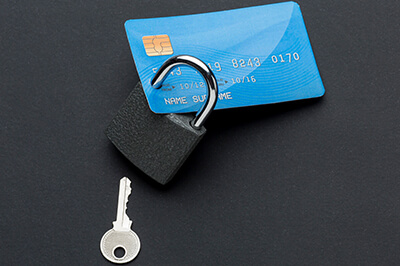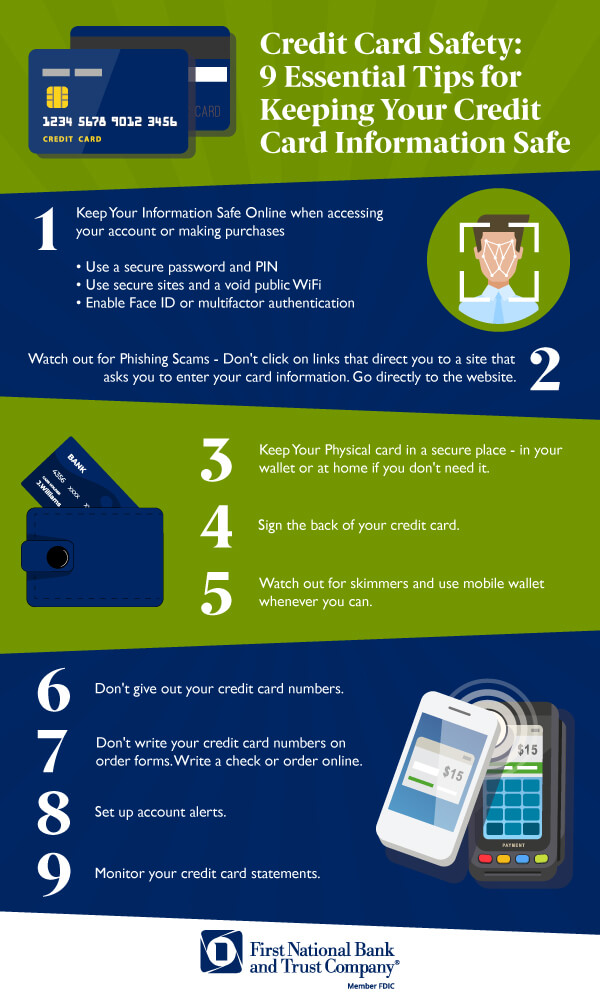Credit Card Safety Tips
Credit card fraud is one of the most common forms of fraud in the country. So, what are the most important credit card security measures you should take to keep your accounts safe?

Credit card fraud is one of the most common forms of fraud in the country. In fact, according to
Security.org, about half of all Americans have had at least one fraudulent transaction on a credit card, with 9% of the population having four or more credit card fraud experiences. Many credit cards feature liability protection against these charges—but that requires consumers to be aware of them, and credit card fraud could be part of a larger issue of identity theft. That’s why it’s so important for individual card users to take steps to protect themselves.
So, what are the most important credit card security measures you should take to keep your accounts safe? There are a few areas to focus on, from practicing safe online habits, staying vigilant against phishing scams, keeping your cards and account information safe, and of course, keeping an eye on your accounts to spot any fraud before it gets too far. Keep reading to learn more about each of these crucial credit card safety tips.
1. Practice Cyber Safety
Most payments now are digital transactions—online, through card readers, or payment apps like Venmo and Zelle. Additionally, all major credit cards will have online platforms to access your card information and monitor activity. Because of this, practicing good cyber habits is essential to protect yourself from fraud. Here are some things you can do to keep your credit card accounts and personal information secure:
- Set up a secure password and PIN. There are lots of tips for creating secure passwords, like making them long, complex, and never reusing them. If it’s hard to remember all those passwords or come up with new ones that fit the bill, use a password manager that can work across devices to generate strong passwords and store them safely. Additionally, avoid reusing PINs, don’t write it down or keep it in your wallet with the card, and don’t use obvious numbers, like birth years or dates.
- Use a VPN if you use public Wi-Fi. If you tend to use your mobile phone or computer for banking on the go, it’s important to use a VPN (virtual private network). Though most websites and apps require security certificates, using a VPN will add an extra layer of protection to everything you do. CNET offers these recommendations for mobile VPN services.
- Use face ID or two-factor authentication. Beyond simple passwords or passcodes, which can be stolen or guessed, both face ID and two-factor authentication (2FA) can provide an additional level of protection for your mobile devices.
- Only make purchases from secure sites. The Better Business Bureau has great advice for how to spot fake websites including examining the URL for errors, looking out for bad design, doing a quick search for reviews for the company, and using Google’s Safe Browsing Tool. Take a minute to verify that the site you are using is legitimate before making a purchase, and if you need to create an account, completely log out of the site when you are done.
2. Watch out for phishing scams.
This is probably the most important advice we can give you about how to keep your accounts safe in today’s online world, because these schemes are increasingly common, and are getting even harder to detect as scammers perfect their methods.
If you receive an email that appears to be from a legitimate source (like a family member, friend, or trusted institution) that (1.) Asks you for money or account information, (2.) Contains urgent requests, and/or (3.) Wants you to log in to your account from a link in the body of the email, STOP, and complete the following safety checks:
- Before you send money or give anyone account information, verify the email came directly from the person or institution. Call your family member or friend, call the phone number on your card, or call your bank.
- Look for red flags. If the email contains typos, bad grammar, or cheap graphics, know that it is most likely a scam.
- Before you click on a link, hover over it and verify the URL—many scam URLs are just one letter away from legitimate sites, so watch out! Even better, type the known URL of the company or institution directly into your browser to log in.
- One more important point; while email is the most common way to get “phished,” remember that these scams can also happen over SMS (text) and social media messages, as well as phone calls. If someone messages you to say you won something, or if someone calls or messages you that you owe money to the IRS, or your car warranty is about to expire, ignore the request—it’s a scam!
Read more about
common cybersecurity threats to avoid.
3. Keep your card safe.
While much credit card fraud today is done through digital methods, it’s still possible for your physical cards, or data from them, to be lost or stolen. Here are a few credit card safety tips:
- Keep your actual card secure. Store it in your wallet, and make sure your wallet is carried in a place that isn’t easily accessible to others. Watch your surroundings—especially if you are out and about in crowded places. If you are traveling, consider a money belt, fanny pack, or neck wallet.
- Sign the back of your card. While most credit card technology today has eliminated the need for signing, some merchants still require it and will take the time to compare signatures.
- Watch out for card skimmers. Card skimmers are particularly common at unattended card readers, like those at gas station pumps. They are physical devices that attach to the terminal. These devices read your credit card numbers directly from the card or get the data from the magnetic strip. You can visit the FTC website for actual pictures of card skimmers and other tips to help you identify them so you know what to watch for.
- Use a mobile wallet whenever you can. Using a mobile wallet is actually safer than physically carrying a credit card and allows you to leave most of your cards at home. Even if your phone is lost, your mobile wallet will require a unique passcode and/or face ID to unlock and access your mobile wallet. Plus, all of the card information is heavily encrypted, so it’s nearly impossible to steal it. To learn more about this safe payment alternative, check out our post: “Benefits of Using A Mobile Wallet”.

4. Protect your account information.
Just as you should protect your physical card, it’s important to keep your account details, including card numbers, security codes, and expiration dates, secure. Here are some simple things you can do to protect your card information:
- Shred statements or sign up for paperless statements. Credit card statements can contain important account and personal information, which could be used to gain access to your credit card account, or to open new accounts in your name. Paperless statements are more secure because they require a login to access that same sensitive information. If you do receive paper statements, store them safely and shred them when you’re done verifying the listed transactions. Additionally, be sure to shred all credit card and loan offers that you receive in the mail to avoid fraud.
- Don’t give your credit card number out over the phone. Giving out your credit card number over the phone, for instance when ordering takeout or making a donation, is one of the most insecure methods of payment—especially if your account number is written down rather than entered directly into the merchant’s payment system. Ask about alternative payment methods if you are prompted to give your credit card over the phone.
- Don’t write your credit card on order forms. There are times when you are given the option to write your card down on an order form as a method of payment – such as for mail order purchases, fundraisers, or donations. That form could be intercepted in the mail, or lost by the person collecting payments, so ask if there are options to pay online. You may also be able to pay by check, but watch out for scams, since you won’t be able to recoup your lost money.
5. Be proactive and take action.
Beyond preventative measures, it’s important to also be proactive, to be ahead of the game in the event that your credit card information is compromised. Here are some tips for what to do to stay alert for fraud and take swift action to stop it before it goes too far:
- Set up account alerts. For most credit cards, if they expect fraudulent activity, you will be notified. However, some accounts, including checking accounts with debit cards, may require you to enroll in text message or other alerts for suspicious activity, or certain transactions. If you aren’t sure if you are enrolled in fraud or activity alerts, reach out to your financial institution to help you review your account settings and alert options.
- Monitor your statements. Every time you get a credit card statement, scrutinize the expenses to make sure that they line up with your actual purchases.
- Check your credit report each year. Checking your credit reports on AnnualCreditReport.com can help you keep track of all your accounts and ensure that no new credit cards have been opened in your name.
- Contact your financial institution if you suspect fraud. If you see any suspicious charges on your account statements, reach out to your bank or credit card company immediately. They will cancel your card, send you a new one, and investigate the suspected fraud.
- File a police report. Credit card fraud can be a form of identity theft, if someone uses your name and personal information to open new accounts. File a claim with your police department if this happens to you. Additionally, if your credit card is lost or stolen, you should report it to your local police department.
Keep Your Accounts Safe with FNBT
At First National Bank and Trust (FNBT), we pride ourselves in maintaining the intimacy of a community bank with modern security features for all of our credit card and online accounts. Our
Personal Credit Cards offer 24/7 cardmember services, as well as Zero Fraud Liability—meaning you won’t be responsible for any reported fraudulent purchases when your card is lost or stolen. Pair your new card with a
Digital Payment service, like Apple Pay, Google Pay, or Samsung Pay digital wallets for added security.
FNBT also offers
checking accounts with identity protection services, including ID Monitoring and Theft Aid, to protect you from identity fraud. To learn more, visit one of our
local branches throughout Southern Wisconsin and Northern Illinois today!
Read more about
mobile banking safety.